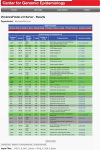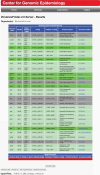Construction of the ETECFinder database for the characterization of enterotoxigenic Escherichia coli (ETEC) and revision of the VirulenceFinder web tool at the CGE website
- PMID: 38656142
- PMCID: PMC11237473
- DOI: 10.1128/jcm.00570-23
Construction of the ETECFinder database for the characterization of enterotoxigenic Escherichia coli (ETEC) and revision of the VirulenceFinder web tool at the CGE website
Abstract
The identification of pathogens is essential for effective surveillance and outbreak detection, which lately has been facilitated by the decreasing cost of whole-genome sequencing (WGS). However, extracting relevant virulence genes from WGS data remains a challenge. In this study, we developed a web-based tool to predict virulence-associated genes in enterotoxigenic Escherichia coli (ETEC), which is a major concern for human and animal health. The database includes genes encoding the heat-labile toxin (LT) (eltA and eltB), heat-stable toxin (ST) (est), colonization factors CS1 through 30, F4, F5, F6, F17, F18, and F41, as well as toxigenic invasion and adherence loci (tia, tibAC, etpBAC, eatA, yghJ, and tleA). To construct the database, we revised the existing ETEC nomenclature and used the VirulenceFinder webtool at the CGE website [VirulenceFinder 2.0 (dtu.dk)]. The database was tested on 1,083 preassembled ETEC genomes, two BioProjects (PRJNA421191 with 305 and PRJNA416134 with 134 sequences), and the ETEC reference genome H10407. In total, 455 new virulence gene alleles were added, 50 alleles were replaced or renamed, and two were removed. Overall, our tool has the potential to greatly facilitate ETEC identification and improve the accuracy of WGS analysis. It can also help identify potential new virulence genes in ETEC. The revised nomenclature and expanded gene repertoire provide a better understanding of the genetic diversity of ETEC. Additionally, the user-friendly interface makes it accessible to users with limited bioinformatics experience.
Importance: Detecting colonization factors in enterotoxigenic Escherichia coli (ETEC) is challenging due to their large number, heterogeneity, and lack of standardized tests. Therefore, it is important to include these ETEC-related genes in a more comprehensive VirulenceFinder database in order to obtain a more complete coverage of the virulence gene repertoire of pathogenic types of E. coli. ETEC vaccines are of great importance due to the severity of the infections, primarily in children. A tool such as this could assist in the surveillance of ETEC in order to determine the prevalence of relevant types in different parts of the world, allowing vaccine developers to target the most prevalent types and, thus, a more effective vaccine.
Keywords: CGE website; ETEC virulence genes; WGS tool; curated database; enterotoxigenic E. coli.
Conflict of interest statement
The authors declare no conflict of interest.
Figures




Similar articles
-
Genotypic and phenotypic characterization of enterotoxigenic Escherichia coli strains isolated from Peruvian children.J Clin Microbiol. 2010 Sep;48(9):3198-203. doi: 10.1128/JCM.00644-10. Epub 2010 Jul 14. J Clin Microbiol. 2010. PMID: 20631096 Free PMC article.
-
Genes Encoding the Virulence and the Antimicrobial Resistance in Enterotoxigenic and Shiga-Toxigenic E. coli Isolated from Diarrheic Calves.Toxins (Basel). 2020 Jun 10;12(6):383. doi: 10.3390/toxins12060383. Toxins (Basel). 2020. PMID: 32532070 Free PMC article.
-
Comparative Genomics and Characterization of Hybrid Shigatoxigenic and Enterotoxigenic Escherichia coli (STEC/ETEC) Strains.PLoS One. 2015 Aug 27;10(8):e0135936. doi: 10.1371/journal.pone.0135936. eCollection 2015. PLoS One. 2015. PMID: 26313149 Free PMC article.
-
Animal Enterotoxigenic Escherichia coli.EcoSal Plus. 2016 Oct;7(1):10.1128/ecosalplus.ESP-0006-2016. doi: 10.1128/ecosalplus.ESP-0006-2016. EcoSal Plus. 2016. PMID: 27735786 Free PMC article. Review.
-
Pig vaccination strategies based on enterotoxigenic Escherichia coli toxins.Braz J Microbiol. 2021 Dec;52(4):2499-2509. doi: 10.1007/s42770-021-00567-3. Epub 2021 Jul 10. Braz J Microbiol. 2021. PMID: 34244980 Free PMC article. Review.
Cited by
-
New insights into the genomic information of an overlooked human pathogen: Bartonella rochalimae causative agent of Carrion's disease.PLoS Negl Trop Dis. 2025 Apr 17;19(4):e0013040. doi: 10.1371/journal.pntd.0013040. eCollection 2025 Apr. PLoS Negl Trop Dis. 2025. PMID: 40245044 Free PMC article.
-
Rapid formulation of a genetically diverse phage cocktail targeting uropathogenic Escherichia coli infections using the UTI89 model.Sci Rep. 2025 Apr 14;15(1):12832. doi: 10.1038/s41598-025-96561-y. Sci Rep. 2025. PMID: 40229393 Free PMC article.
-
Emerging multi-drug resistant and extended-spectrum β-lactamase (ESBL)-positive enterotoxigenic E. coli (ETEC) clones circulating in aquatic environments and in patients.One Health. 2025 Jan 10;20:100968. doi: 10.1016/j.onehlt.2025.100968. eCollection 2025 Jun. One Health. 2025. PMID: 39898314 Free PMC article.
References
-
- Havelaar AH, Kirk MD, Torgerson PR, Gibb HJ, Hald T, Lake RJ, Praet N, Bellinger DC, de Silva NR, Gargouri N, Speybroeck N, Cawthorne A, Mathers C, Stein C, Angulo FJ, Devleesschauwer B, World Health Organization Foodborne Disease Burden Epidemiology Reference Group . 2015. World health organization global estimates and regional comparisons of the burden of foodborne disease in 2010. PLoS Med 12:e1001923. doi:10.1371/journal.pmed.1001923 - DOI - PMC - PubMed
-
- Kotloff KL, Nataro JP, Blackwelder WC, Nasrin D, Farag TH, Panchalingam S, Wu Y, Sow SO, Sur D, Breiman RF, et al. . 2013. Burden and aetiology of diarrhoeal disease in infants and young children in developing countries (the global enteric multicenter study, GEMS): a prospective, case-control study. Lancet 382:209–222. doi:10.1016/S0140-6736(13)60844-2 - DOI - PubMed
-
- Murphy D, Ricci A, Auce Z, Beechinor JG, Bergendahl H, Breathnach R, Bureš J, Duarte Da Silva JP, Hederová J, Hekman P, et al. . 2017. EMA and EFSA joint scientific opinion on measures to reduce the need to use antimicrobial agents in animal husbandry in the European Union, and the resulting impacts on food safety (RONAFA). EFSA J 15:e04666. doi:10.2903/j.efsa.2017.4666 - DOI - PMC - PubMed
MeSH terms
Substances
Grants and funding
LinkOut - more resources
Full Text Sources
Medical
Research Materials
Miscellaneous

